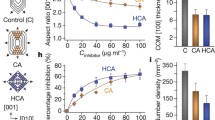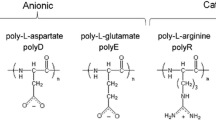Abstract
Acidic proteins found in mineralized tissues act as nature's crystal engineers, where they play a key role in promoting or inhibiting the growth of minerals such as hydroxyapatite and calcium oxalate. Despite their importance in such fundamental physiological processes as bone and tooth formation, however, there is remarkably little known of the protein structure-function relationships that govern crystal recognition. We have taken a model system approach to elucidate some of the relationships between protein surface chemistry and secondary crystal growth of biological minerals. We show here that the distribution of electrostatic surface charge on our model protein, Protein G, determined whether the secondary growth of calcium oxalate, the principal mineral phase of kidney stones, was promoted or inhibited when the proteins were preadsorbed at low and equivalent surface coverages of <10%. The native Protein G, which contains 10 surface carboxylates, increased the rate of calcium oxalate growth from aqueous solution under constant composition conditions up to 97%, whereas a site-directed mutant with six of the surface charges removed inhibited the growth rate by 60%. The adsorption isotherms of both proteins were determined and suggested that the differences in electrostatic surface properties also lead to differences in protein orientation on the crystal surface. These results demonstrate that differences in electrostatic surface potential of proteins can directly determine whether secondary calcium oxalate growth is promoted or inhibited, and a model is proposed that suggests the distribution of carboxylate residues determines the interrelated binding orientation and exposed surface chemistry of the adsorbed Protein G.
Similar content being viewed by others
Author information
Authors and Affiliations
Additional information
Received: 4 May 1998 / Accepted: 1 November 1998
Rights and permissions
About this article
Cite this article
Clark, R., Campbell, A., Klumb, L. et al. Protein Electrostatic Surface Distribution Can Determine Whether Calcium Oxalate Crystal Growth is Promoted or Inhibited. Calcif Tissue Int 64, 516–521 (1999). https://doi.org/10.1007/s002239900642
Published:
Issue Date:
DOI: https://doi.org/10.1007/s002239900642




